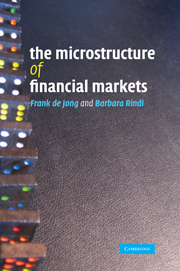Book contents
- Frontmatter
- Contents
- List of figures
- List of tables
- Preface
- Introduction
- 1 Institutions and market structure
- 2 Financial market equilibrium
- 3 Batch markets with strategic informed traders
- 4 Dealer markets: information-based models
- 5 Inventory models
- 6 Empirical models of market microstructure
- 7 Liquidity and asset pricing
- 8 Models of the limit order book
- 9 Price discovery
- 10 Policy issues in financial market structure
- Index
Introduction
Published online by Cambridge University Press: 05 June 2012
- Frontmatter
- Contents
- List of figures
- List of tables
- Preface
- Introduction
- 1 Institutions and market structure
- 2 Financial market equilibrium
- 3 Batch markets with strategic informed traders
- 4 Dealer markets: information-based models
- 5 Inventory models
- 6 Empirical models of market microstructure
- 7 Liquidity and asset pricing
- 8 Models of the limit order book
- 9 Price discovery
- 10 Policy issues in financial market structure
- Index
Summary
In the traditional approach to financial economics the price formation process is a ‘black box’ in which there is no explicit role for financial market structure. Aspects such as dealers, spread and the organizational structure of financial markets are ignored. In Stoll's (2000) words, ‘thirty years ago friction in financial markets was largely ignored in the theory of finance’. In the last two decades a substantial literature on the process of financial price formation has developed and is generally known under the name market microstructure. This literature relaxes the assumptions of the traditional asset pricing models, such as the absence of transaction costs, homogeneous and symmetric information, and looks inside the ‘black box’ to get a better understanding of intraday price dynamics. A related objective is to formulate recommendations for the optimal design and regulation of financial markets. Market microstructure also provides new techniques for estimating transaction costs and market liquidity. This is of practical relevance for professional investors, who are interested in efficient order execution and the effect of liquidity on asset prices.
Amihud and Mendelson (1987) was one of the first papers to draw researchers' attention to the relevance of market structure. They found that the variance of the open-to-open returns was higher than that of the close-to-close returns for the hundred most liquid stocks on the New York Stock Exchange (NYSE). This suggested that, due to the different market organization of the opening and the closing, agents trading at the opening were exposed to greater volatility than traders at the close.
- Type
- Chapter
- Information
- The Microstructure of Financial Markets , pp. 1 - 6Publisher: Cambridge University PressPrint publication year: 2009



